Ring Muscle up Tutorial
In this article we will guide you through each and every step of the way to achieving your first ring muscle up . And if you already are in the muscle-up club


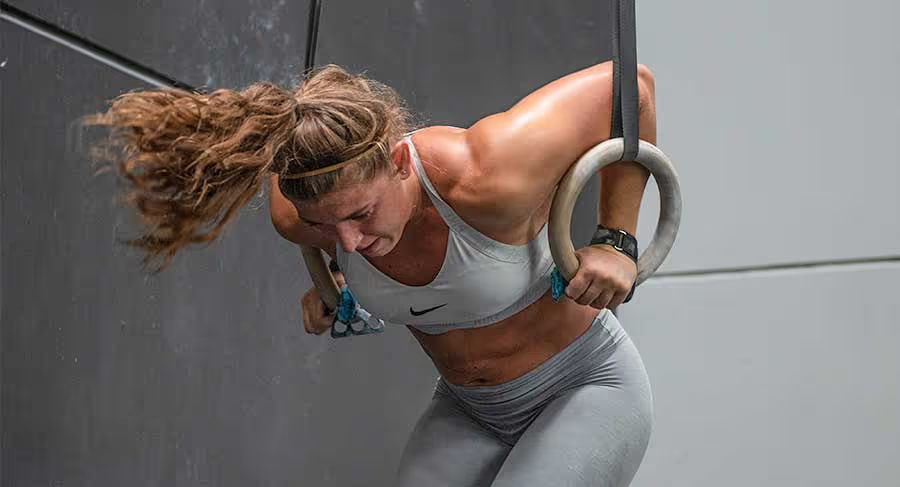
In this article we will guide you through each and every step of the way to achieving your first ring muscle up . And if you already are in the muscle-up club


In this article we will guide you through each and every step of the way to achieving your first ring muscle up.
And if you already are in the muscle-up club but struggle with stringing them together or performing them under fatigue make sure to stick around as we will also cover some exercises to improve on those issues as well.
For those of you who aren’t very familiar with crossfit jargon a ring muscle up is a very high skill gymnastics movement. To break it down to it’s bones it’s a kipping pullup, followed by a “in air” sit up and closed with a dip, all performed on a set of rings of course.
If you still are puzzled let us explain with a little more depth:
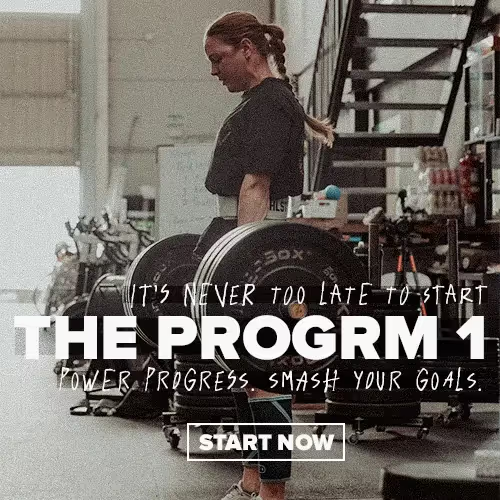
The ring muscle up is undoubtedly one of the most complex movements to master in Crossfit. As we said it requires both pulling and pushing strength, lot’s of body awareness and a strong core.
Sure you can get your first muscle up by sheer “strength of will” but it probably won’t be an efficient RMU. If a movement lacks efficiency it will be harder for you to accumulate the necessary volume to perform it well in a wod or competitive setting. Additionally when you don’t have the baseline strength to correctly perform a movement you put yourself at a much higher risk of injury.
This is why it’s important to build yourself up to it through specific drills and strengthening exercises.
In this article we are covering the steps to learn the kipping ring muscle up.
It’s important to differentiate between the strict and kipping version of this movement.
Although they essentially consist of the same pullup-transition-dip movements the kipping requires much more skill and coordination whereas strength is the determining factor in the strict variation.
Ideally if you have the strength to perform a strict ring muscle up you should be able to perform a kipping muscle up, unfortunately this isn’t always the case.
This is because the strict variation doesn’t require the coordination component of quickly piecing together the kip+pull into the push back+sit up seen in the kipping one.
Additionally it’s much easier to utilize a false grip in the strict RMUs compared to the kipping which puts the athlete to an advantage throughout the movement.
Often athletes who are very strong but need more sense of awareness and control over their body will struggle with kipping RMUs even though they may have multiple strict RMUs.
The key to fixing this issue is going over movement drills enough times that your brain will eventually “know” what to do and what positions to move through without you needing to think about it too much.
Lastly, before we dive into our progressions, we wanted to give you guys a quick breakdown of the difference between standard grip and false grip.
In essence false grip should be used for strict muscle ups whereas standard grip is recommended for kipping ring muscle ups.

This is because it is quite hard to hit the correct body positions in the kip while using a false grip and in the kipping movement hitting a proper hollow-arch (check our toes to bar tutorial for more arch-hollow movements) is essential for efficiency.
On the other hand a false grip will give you a better leverage in a strict RMU, this is because you are literally shortening your lever, aka your arms.
By a physics standpoint this puts you at an advantage during the transition.
Additionally because in the strict movement there isn’t a moment of weightlessness in the transition that allows you to shift and readjust your hand position utilizing a false grip allows to have adequate positioning both for the pull and dip.
Lastly when utilizing a false grip you may notice more engagement of your lat muscles, this added activation allows for a stronger pull which will make your strict ring muscle up that much easier.
Phase 1
Baseline strength
Upper body pressing strength is necessary to perform the dip and complete your muscle-up rep.
If you are able to move through sets of slow and controlled push-ups then you can scale up to the actual dipping movement.
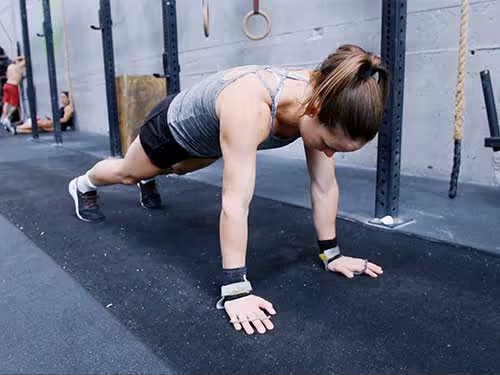
You can start from parallettes, if you have them, so to remove the innate instability element of the rings.
Once you’re comfortable with the movement you can move to ring dips. If you don’t have parallettes or parallel bars at your gym but still don’t feel comfortable diving right into “normal” ring dips you can utilize a band.
Simply tie the band onto one ring and hold it still with your hand on the other. When starting your set simply step onto the band while holding it still.
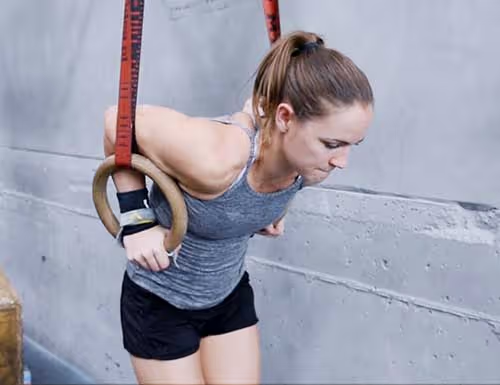
The band will partially support your weight and allow you to more easily perform sets of ring dips and get accustomed to the movement and added instability.
Once you’re comfortable it’s time to move onto the real deal, work on moving through the whole range of motion of the ring dip: from a controlled lock-out position on top to your shoulders touching the rings in the bottom position.
If you can perform strict rings dips your life will be much easier when learning muscle-ups. It’s a common problem we see with athletes who complete the transition but then are unable to dip out from the bottom position and close the rep.
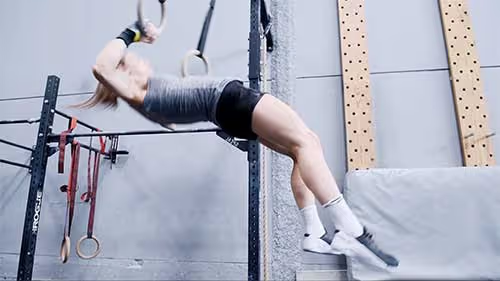
Here we’re looking for you to be able to perform chest-to-bar pull-ups, this is because the higher we can get in our pulling motion the easier the transition into the dip will be.
Start from testing your strength on a gymnastics bar and then move onto the rings.
When performing ring-pullups make sure you’re maintaining a hollow position.
This is very important when moving onto the next section of your pulling strength. That is the ring swings of course
Phase 2
Ring swings are essentially the first step of a ring muscle up.
Just as you have kip swings on a gymnastics bar, ring swings introduce that elastic reaction that allows you to accelerate your body and ultimately “throw yourself” over the rings and into the muscle up.
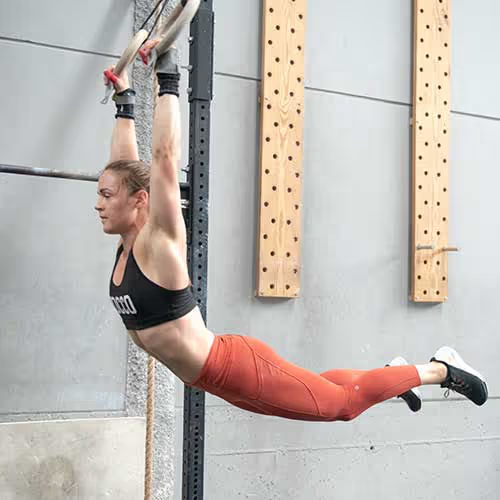
This can’t be done if you aren’t tight throughout the movement.
Our tip is to practice sets of 5 or so ring swings focusing on maintaining the hollow and arch positions respectively when moving backwards and forwards.
When practicing also remember to pull back onto the rings slightly to control the movement.
Once comfortable with the swings it’s time to add in an extra pulling component.
We want you to perform a swing into a chest pull. When stringing multiple reps of swings and pull together you might struggle with balance and keeping the movement smooth each rep.
Here is where practice and aiming for quality movement will come into play. Also don’t forget all the cues we previously discussed.
The best way to go about the transition is to imagine it as a quick sit-up that you perform right at the end of your ring to chest pull.
As easy as this may sound, it is also true this is where we see most athletes struggle.

The struggle can be tied to a variety of reasons from catching the dip too low as well as struggling to get out of that low position, or the catch could be very off balance due to bad timing.
That’s why we have even our most elitè athletes practice the support swings and the dip swings drills. The set up for both drills is the same: stack up either some box jump boxes or, if you have them, jerk block.
Position them at the same distance you’d keep your set of rings. On top of the blocks position two sturdy dumbells.
Ideally when assuming the bottom position of your dip while supporting yourself on said dumbells you should not be touching the ground. From here you will want to practice swinging your body, first while maintaining the bottom dip position (support swings).
When done correctly you’ll notice that when you are swinging your body backwards there will be a moment where your body starts rising and feels lighter on your shoulders.
That is the moment you must take advantage of when dipping out of your ring muscle up.
To further drill this concept down the next step is to practice the dip swings, start by performing support swings and when you feel that moment of weightlessness at the end of the backward swing dip out of the bottom position.
To build capacity you can then move onto repeating this drill over multiple reps.
Once comfortable, move these drills to the rings to get accustomed to the instability of the rings and work with their momentum.
Phase 3
After Phase 1 and 2 it’s time to put all the pieces together.
Before your attempt make sure you warm up and prep both muscles and nervous system by going through some of the drills and movements we talked about earlier.
Remember to work with the movement of the rings and not against it, and make sure your “sit up” on the transition is as fast as can be.
This is crucial for catching the dip in the right positioning and will make your life much easier when it comes to closing the rep.
Extra tips
We have a couple pointers for those who struggle with transition (which we know has been most of us at one point or the other).
Going back to our boxes from the dip swings, but with no dumbells this time, start with your forearms and palms fully in contact with the top of the boxes.
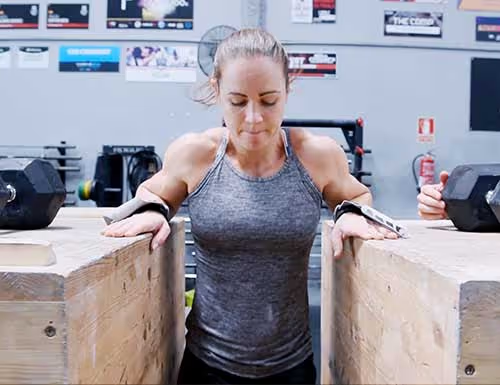
You will be supporting yourself on your legs at the start of the movement, but then you will shoot forwards mimicking the transition movement of the muscle up.
Push yourself onto your palms lifting your elbow and forearms to end up in a deep bottom position dip. You can then dip out or return back to the starting position for another rep.
This drill is not as much of a strengthening exercise as more of a way to build your confidence in this peculiar and unique part of the ring muscle up.
It truly is a movement “pattern” we otherwise don’t see in Crossfit therefore getting comfortable with it through something like russian dips can have a huge transfer into the complete movement.
Ring complexes are something we often program within both our Daily programming as well as our gymnastics specific program.
This is because they test both your stamina on the rings as well as help develop body awareness and efficiency.
The most common and basic ring complex is essentially a mash of all the movements we just went over:
Once you’re comfortable with doing one full complex you can start adding reps of each movement or try performing back to back complexes to test you control of the rings.
We hope this article was useful to you, make sure to tag us on social media if you try any of these drills. For an even more in depth breakdown of the steps to learning the ring muscle up you can check the video embeded at the begining of this article where we go over each phase with Head Coach John Singleton and elitè athlete Jacqueline Dahlstrom.